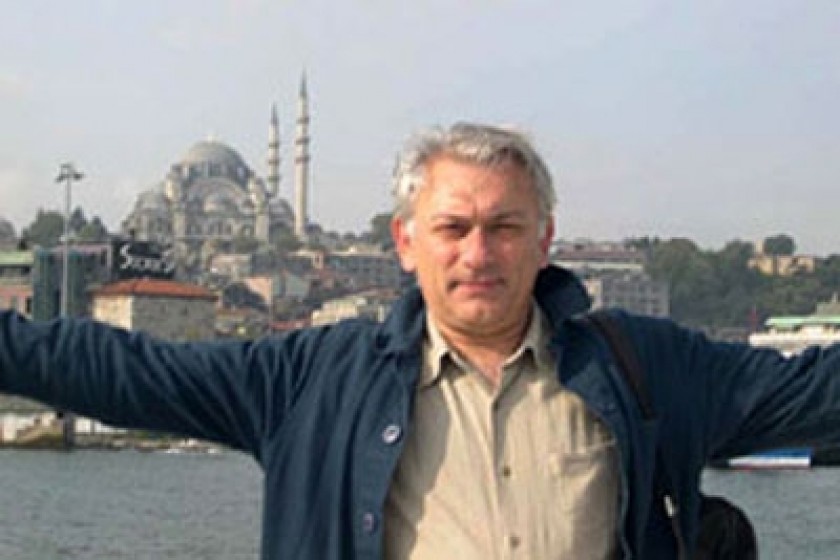
The Return to the Future
1987. I am invited to the International Theatre Festival in Istanbul, but only for a few days. It is my first time here. Istanbul, the same city that my grandfather used to call Polis, i.e. the city of cities. The military government has just given way to the new elected government and the European Union has just recognized the Armenian Genocide. Soloz is somewhere between the city Bursa and Lake Iznik, on the opposite coast of the Marmara Sea. I fail to find it on the map. I am either blinded because of emotions or the village does not exist in reality. I would like to see Solots of Avetis. But how.
In the square of the Turkish village of Soloz, Armenian gravestones are laid together, the stones which his grandfather told him about so much. The scriptures on the stones are not just epitaphs but whole poems: short, simple, silent remains of the culture of the people who once lived here.
Despite the camera on his shoulder, he is not here for journalistic reasons or film research. He just came here on the trail of his grandfather, who was resettled and sent to the desert Der Zor along with the other inhabitants of the village by the Ottoman government.
But how can he explain that to the quiet, mustachioed head of the village, who claims that the fact that these stones are here is a big shame and that filming is strictly banned?
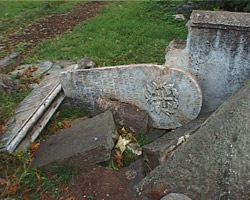 |
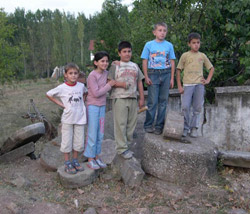 |
He nevertheless manages to keep the frames already shot. He returns to France.
His next visit to Soloz takes place 16 years later, in 2003.
"I looked at the images of 1987 for many years very often spoke of my unfinished journey to the village of Soloz. Jose's (the photographer accompanying him)photographs were to become a book, but that project was not completed.
"In October 2003, due to one of my films, The Long Line, I was invited to the European Film Festival in Bursa. The trip is a real gift for me, a new reason to go back to Soloz, a return which seems inevitable to me."
He meets the same people, they recognize him; tell about the changes in their lives so far. Some of them are no longer alive. The head of the village has been replaced.
The gravestones are no longer in the small square. A young man says that he moved them to the temporary museum and intends to build a permanent museum for them to support tourism development in the village.
His third return to the village takes place in 2005.
"This time we are going back to the time when the European Council has to say its bit about the negotiations around Turkey's entry into the European Union. The higher authorities in Ankara are slow at giving us permission to film. The dialog between Armenians and Turks is still a very delicate and dangerous position. My grandfather could never have imagined that his grandson would decide to tell the story of his village."
He again meets the head of the village, who was reelected after a break of more than 16 years. This time the head is better disposed toward him. The villagers are very welcoming, but how far can he go with his questions about their common history?
The villagers now are more ready to communicate, they also tell their stories which are so similar to Armenian ones; and this seems to create a subtle connection between them. The dialogue finally takes place, the dialogue between an Armenian and the Turks.
The film To Return by French-Armenian actor and director Serge Avedikian won the FIPRESCI award at the third Golden Apricot International Film Festival. It is hard to categorize the film. The film is neither in the documentary nor the "other" category because of how subjective and extremely personal it is.
When people who had already seen the movie advised me to watch it, they would characterize it as a "film about the Genocide." But that is not correct. The theme of the Genocide is touched on in the film indirectly. The core of the film is not a look back to the past tragedy but a dialog between the Armenian and the Turks, an interpretation of our common history and an attempt to find an exit from the deadlock of Armenian-Turkish relations. Not forgetting the past, let us look to the future, is what the film says.
An interview with Serge Avedikian
Unlike other Armenian authors referring to the Genocide issue, your work seems to be the first one that does not concentrate on the syndrome of "the massacred nation" and suggests changing the uncompromising position into a dialogue.
Armenian directors shooting a film are unconsciously under the pressure of our history, as if they have the whole nation behind them looking at their work. There are not many films about the Genocide; thus directors try to say everything in one film. I have to confess that while I was editing I also felt that pressure on me. There is a lot of footage that didn't make it into the finished film. For example, at first I was going to tell about the preserved Armenian Church in the next village as well, but then realized it would destroy the film's balance and would be an attempt to assign blame.
But my aim was not to blame. That was another difficulty with the film. The work is first of all subjective, based on my personal feelings, about emotions connected to my grandfather's village and communication with the Turks. On the other hand I tried to be totally unbiased, not to judge but to try to speak. We are suffering from a massacred nation's pathology: "The Turks are the enemy, and any communication with the enemy is impossible." I show in my film that dialogue is possible and necessary.
Was the idea of the film born after the first visit?
The idea to make this film was born on the second visit. After the first one I did not have enough material for a movie. Most of the villagers knew nothing about our history and so were not interested in speaking. On the second visit I was very short of time. But I saw now that they wanted to speak, to listen to and to talk.
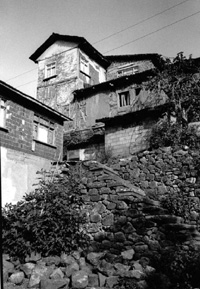 |
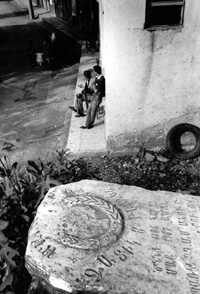 |
During the first visit I found out that the villagers themselves are immigrants, so they know what it is to leave their home and to live in their psychology. Their ancestors were not native Turks, but are pomates, Islamized people from Drama, Thessaloniki, who were brought here in the 1923 peoples' exchange when the Christians from Turkey moved to Greece and the Muslims living in Greece came to Turkey. About a million people left Turkey and 400,000 came to Turkey. Thus the Turks filled the Armenian villages with the Muslims.
How do you think the dialogue would have gone if they had been native Turks?
I think, much more difficult. But even in this case it was not easy to begin the dialogue. I could only guess what response I would get and how far I could go.
The majority of the villagers did not believe that massacres took place. One day the historians say 600,000, another day a million, whom must we believe now? says one of them. They left the place as a result of a peoples' exchange. They were moved, but then many of them came back.
Other opinions were, You say there was Genocide; we say there was not. Our information about the past is unclear; we did not live that time, and no one knows what happened in reality .
But some say that despite claiming that the Genocide did not happen, they are ready to hear about it, to discuss it.
To me what is very important in the film is that I present the history of the villagers as well. First my grandfather tells me the story of the Armenians who once lived here. Then the villagers tell their story, which is very similar to the Armenians' fate.
I also show that some of their attitude is born of illiteracy. I mean most of them do not know what happened and they need to be told about it.
When that boy said he wanted to open a museum for the gravestones to promote the tourism in Soloz I got angry. Who will visit the museum? Armenians, of course! They destroyed our cemetery and now we have to pay to visit them! But then I looked at it from another point of view; it is also a way to preserve them. Besides, the Armenians visiting the museum will come into contact with the locals, who will tell them about their ancestors. So I said I agreed to help them with the museum.
The structure of the film is very interesting - a tree returns to the same place, with the same people.
The film unconsciously has a structure from Greek mythology. That repetition, the evolution of human relations in the same place.
The story of the creation of Solots is also mythological. That part is present in the film:
Argonaut Tatsios walks with his friend Solois on the bank of Lake Iznik. Solois meets beautiful Ansiope and falls in love with her. But his love is unrequited. In despair, Solois throws himself into the water.
In deep grief for his friend's inglorious death, Tatsios builds a village at the place when Solois died and names the village after his friend. The brothers of Solois settle in the village, which comes to be called Soloz.
There are also grotesque aspects to the film. Some villagers treated me with hostility because, according to legend, there are countless treasures hidden in the village and they believed I knew the place and had come to take them.
What was the response to the film in France?
The film is personal and the issue is complicated for the audience. It was also hard for the state TV channels in France to accept the movie. Although the film is positive, in France there are other criteria: if they present a movie on some issue they have to present a film on the same issue with the opposite side's point of view as well so that the justice is maintained.
TV channels in general want simpler, more concrete documentaries. I think I will edit another version for television taking out my personal emotions as much as possible.
What about the response in Armenia? Was it expected?
I was very happy and moved to getting only positive responses to the film. Young people are particularly positive to the dialogue.
Now the Turkish press speaks around the Genocide topic much more because it is a part of entry into the EU. There are about 60,000 Armenians in Istanbul who have been silent so far. But now the paperAkos, which is both in Armenian and Turkish, and the Turkish intelligentsia is speaking up about the Genocide. It is not easy for them because of the pressure by the government, but the movement has already begun.
It was very hard for me to end the movie, because the relationship between the Turks and Armenians is not finished so what end should my film have?
The movie ends on two important points. One is my question, 'When will Turkish nationalism end?' because there were people in Soloz who told me they would like to study the Genocide issue to find out the truth, but believed it was impossible with the current policy of the Turkish government.
And the second point is the film ends with the children on the gravestones. I ask one of them if he knows whose graves they used to be on. He says he knows they were on Armenian graves. As my grandfather told me about the gravestones, he also knows that story from his grandfather.
 Videos
Videos Photos
Photos
Write a comment